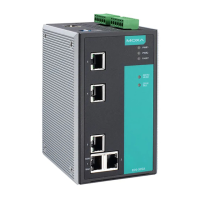
Do you have a question about the Moxa Technologies Managed Ethernet Switch/Extender and is the answer not in the manual?
| Brand | Moxa Technologies |
|---|---|
| Model | Managed Ethernet Switch/Extender |
| Category | Network Router |
| Language | English |
Explains the initial installation process for Moxa switches, covering serial, Telnet, and web console access.
Details configuration, monitoring, and administration functions accessible via serial, Telnet, or web console.
Guides users through connecting and configuring the switch via its serial console port using a terminal emulator.
Explains how to access and configure the switch using a Telnet client over a network.
Describes how to access and configure the switch using a web browser interface.
Provides instructions on disabling Telnet and web consoles for enhanced security when managing the switch.
Covers essential settings like system identification, passwords, and IP access control for switch management.
Details port configuration, including trunking for bandwidth aggregation and basic port settings.
Explains SNMP, IEEE 1588 PTP synchronization, and system file update procedures.
Covers PoE functionality, Virtual LANs for network segmentation, and fast recovery mechanisms.
Details QoS for traffic prioritization, bandwidth management, and multicast filtering.
Outlines security features like user authentication, port access control, and automatic event warnings.
Introduces tools for monitoring performance, diagnosing issues, and managing logs.
Instructions on how to launch the Moxa EtherDevice Server Configurator utility.
Utility to search for Moxa switches on the local LAN via MAC address.
Method to locate a specific Moxa switch by its IP address.
Steps to update the Moxa switch firmware to the latest version.
Function to reconfigure the switch’s IP address, subnet mask, gateway, and DNS settings.
Utility to save the current switch configuration to a text file.
Function to load a saved configuration file onto the switch.
Procedure to unlock a password-protected switch for configuration management.
Standard MIB group for system-related information.
Standard MIB group for network interface details.
Standard MIB group for IP address and related information.
Standard MIB group for Internet Control Message Protocol statistics.
Standard MIB group for Transmission Control Protocol connections and statistics.
Standard MIB group for User Datagram Protocol connections and statistics.
Standard MIB group for Ethernet transmission statistics.
Standard MIB group for SNMP agent statistics.
Standard MIB group for bridging information and spanning tree protocol.